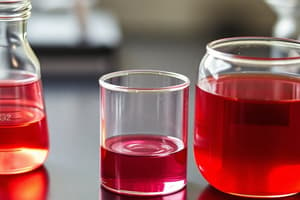Podcast
Questions and Answers
Which separation technique would be most effective for separating a mixture of iron filings and sand?
Which separation technique would be most effective for separating a mixture of iron filings and sand?
- Chromatography
- Magnetic Separation (correct)
- Filtration
- Decantation
Which of the following represents a molecule?
Which of the following represents a molecule?
- H
- H₂O (correct)
- NaCl
- O
Which scientist proposed the Plum Pudding Model for the atom?
Which scientist proposed the Plum Pudding Model for the atom?
- Niels Bohr
- Ernest Rutherford
- John Dalton
- J.J. Thomson (correct)
Which type of bonding involves the sharing of electrons between atoms?
Which type of bonding involves the sharing of electrons between atoms?
What is the mass number of an atom with 12 protons and 14 neutrons?
What is the mass number of an atom with 12 protons and 14 neutrons?
Which of the following techniques is used to separate a mixture of coloured dyes?
Which of the following techniques is used to separate a mixture of coloured dyes?
The chemical formula H₂O represents which type of compound?
The chemical formula H₂O represents which type of compound?
Which of the following is a common misconception about Dalton's Atomic Theory?
Which of the following is a common misconception about Dalton's Atomic Theory?
Flashcards
Liquid-Vapor Condensation
Liquid-Vapor Condensation
A technique that converts liquid into vapor and back to liquid to separate components, often used in crude oil processing.
Filtration
Filtration
A method used to separate solid matter from a liquid by using a permeable barrier or filter medium.
Centrifugation
Centrifugation
A separation technique that uses centrifugal force to segregate particles in a mixture based on their densities.
Accuracy vs Precision
Accuracy vs Precision
Signup and view all the flashcards
Atom
Atom
Signup and view all the flashcards
Ion
Ion
Signup and view all the flashcards
Ionic Bonding
Ionic Bonding
Signup and view all the flashcards
Chemical Formula
Chemical Formula
Signup and view all the flashcards
Study Notes
Separation Techniques
-
Filtration: Separates solid and liquid mixtures using a filter medium. The filter traps the solid while the liquid passes through.
-
Chromatography: A lab technique used to separate components of a mixture based on their differing affinities for the stationary and mobile phases.
-
Centrifugation: Separates components of a mixture based on their different densities using centrifugal force.
-
Decantation: Separates a liquid from a solid by carefully pouring off the liquid, leaving the solid behind.
-
Evaporation: Separates a solution by heating it until the solvent turns to vapor, leaving the dissolved solid behind.
-
Magnetic Separation: Separates magnetic materials from non-magnetic materials by using a magnetic field to attract and separate the magnetic material.
Measurements
- Accuracy: How closely a measured value agrees with the correct value.
- Precision: How closely individual measurements agree with one another.
Atoms, Molecules, and Ions
- Atom: The smallest unit of matter.
- Molecule: A combination of two or more of the same atoms.
- Compound: A combination of two or more different atoms.
- Democritus proposed the concept of "atomos" (indivisible particles)
Atomic Structure
- Atomic Number (Z): The number of protons in an atom's nucleus.
- Mass Number: The sum of the number of protons and neutrons in an atom's nucleus.
- Proton: Positively charged particle in the atom's nucleus.
- Neutron: A neutral particle in the atom's nucleus.
- Electron: Negatively charged particle found outside the nucleus in electron shells.
- Ion: A charged atom or molecule.
- Isotopes: Atoms of the same element with different numbers of neutrons.
Chemical Bonds
- Ionic Bond: Forms between metal and nonmetal atoms as one atom transfers electrons to another.
- Covalent Bond: Forms when atoms share electrons. Usually between nonmetal atoms.
Representing Compounds
- Chemical Formula: Represents the elements present and their relative numbers in a compound.
- Molecular Formula: Shows the actual number of atoms of each element.
- Empirical Formula: The simplest whole-number ratio of atoms in a compound.
- Structural Formula: Shows the actual number of atoms and bonds between them.
- Molecular Models: 3D representations of molecules where atoms are represented by balls and bonds by sticks.
Atomic Theories
- Dalton's Atomic Theory: Introduced the concept of atoms as fundamental building blocks of chemical structures.
- Thomson's Plum Pudding Model: Proposed that atoms contain negatively charged electrons within a positively charged sphere.
- Rutherford's Nuclear Model: Suggested the existence of a dense, positively charged nucleus containing most of the atom's mass.
- Bohr's Planetary Model: Described electrons as orbiting the nucleus in specific energy levels or shells.
- Schrodinger's Quantum Model (Modern Model): Describes electrons as existing in orbitals/electron clouds.
Studying That Suits You
Use AI to generate personalized quizzes and flashcards to suit your learning preferences.





